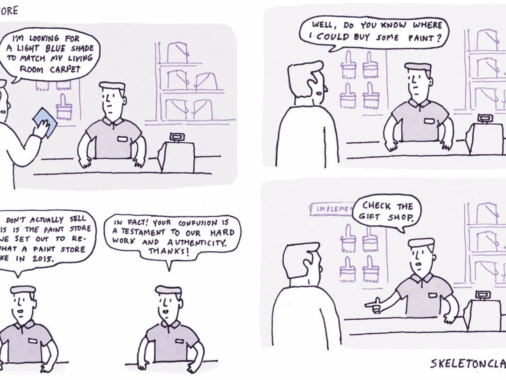Can the seemingly opposing forces of intuition and scientific thinking be leveraged to fuel novel and creative user experience explorations?
I like to think of my mind like a ping pong game where creativity and intuition represent one half of the table and logic and reasoning represent the other half. What ensues is an epic back and forth rally of thoughts and ideas. My hunch tells me most of my fellow UXRs can identify with this idea and the UX discipline by its innate nature uniquely benefits from a ping pong mind.
If that’s indeed true, then why is the dilemma of intuition vs scientific thinking so prevalent? Can these two strategies for gaining actionable knowledge co-exist?
I am by no means the first person to explore these two constructs but I’d like to share some key insights from my research to build the argument in favor of scientific intuition for UX. Let’s explore the above questions in a step-by-step manner by addressing the following key areas:
- What does the scientific method entail? – Its merits and demerits
- What is intuition? – Its merits and demerits
- The Western and Traditional cultural influence
- Practical application of scientific intuition in UX processes
- Conclusion
What does the scientific method entail?
The scientific method is one of the more widely understood processes of obtaining evidence-based subject matter knowledge. It is a process of carefully and systematically collecting and evaluating empirical evidence to test ideas and answer questions.
The scientific method exerts strong emphasis on empiricism and rationalism. It readily accepts errors in previous conclusions when more data is available that can state a more explicit and inclusive hypothesis.
A scientific approach as we know typically involves the following sequence:
- Hypothesize – Good testable hypotheses are crucial to identify actionable insights in a successful study. Specific and measurable hypotheses inform the right outcome metrics, research methods to be used and tasks to be performed to test the hypotheses.
- Operationalize – This step involves methodically identifying metrics, methods, and corresponding tasks to collect the right data and measure desired user behavior.
- Test and Observe – The next step is to monitor, log and quantify user behavior in terms of the actions performed and attitudes displayed by the user while performing prescribed tasks in a controlled simulated or an IRL setting.
- Analyze – Finally, data from disparate channels is compiled for analysis, computation, and comparison, or for applying the right statistical tests to identify key insights that’ll either validate or invalidate the initial hypotheses and help stakeholders make critical decisions.
Limitations of the scientific method
There are limitations to the scientific method approach including:
- It is not always feasible to use. In the sense that this method can require considerable time, logistical planning, and resources.
- A highly controlled and monitored testing environment may elicit circumstantial insights and lack validity in a real-world environment that involves complex interdependencies.
- Biases in recording objective data may affect the reliability of the data collected and its corresponding assessment.
- Hawthorne effect – Observer bias can also occur when the subject knows they are being examined, causing them to act differently from how they normally would.
- It can only be used to address empirical questions. That means that, since we cannot often measure what we want to measure, we develop some sort of proxy metrics that make the best of a bad job.
- The scientific method is agnostic to value judgment or morality — whether things are good or bad, just or unjust, or beautiful or ugly, legality/ illegality of something, or how the world ought to be.
- It’s often challenging to quantitatively capture the user’s latent temperament or motivations that contain far richer insights into the resulting actions and attitudes.
What is intuition?
All of us at some point have felt that “AH-HA!” or the “eureka!” moment of sudden revelation or that “gut feeling” in a confusing or unsound situation.
The term intuition is derived from the Latin word intueri which means “to see within”. It is a way of obtaining knowledge or sensing the truth that cannot be acquired either by inference or observation. The intuitive impressions generally come in a variety of different ways namely, Clairvoyance (clear seeing or clear vision), Clairaudience (clear hearing), and Clairsentience (clear sensing). Intuition can be thought of as an instinct that manifests spontaneously in an unpremeditated process. This process helps us make life-and-death decisions in split seconds and this, according to the System 1 thinking described by Daniel Kahneman, is the reason intuition evolved in the first place — it increases our chances of survival.
The scene from Initial D anime illustrates how intuition flowers in the most intense and time-sensitive situations. It does so by helping the mind simultaneously process a gamut of external stimuli, react and monitor the corresponding interactions. It is not an irrational, illogical, or unsubstantiated process devoid of trustworthy data. It is, in fact, a continuous and ubiquitous process that leverages past knowledge and experiences to connect the dots and identify patterns normally unseen by the peripheral senses and inexplicable by reason.
Limitations of intuition
Kahneman in his book Thinking, Fast and Slow, mentions that for intuition to work, three conditions are required to be satisfied: regular order, as in the variables in a given environment don’t change too abruptly; lots of practice or previous experience; and immediate feedback, that is, you have to know almost immediately whether you got it right or got it wrong. Kahneman states, “unless those three conditions are satisfied, the mere fact that you have an idea and nothing else comes to mind, and you feel a great deal of confidence — absolutely does not guarantee accuracy.”
A study conducted by Joel Pearson to quantitatively measure intuition found that information intuitively perceived in the brain will help with decision-making if that information holds some value or extra evidence beyond what people already have in their conscious mind.
- Unpacking Kahneman’s first condition, in a fast-paced and ever-changing business, you can’t always afford a “regular order”. Guidance and directives from upper management are subject to change and historical evidence abounds examples of how fickle the complex and interdependent moving parts of global markets can be.
- Intuitions are acquired by previous experience, and the benefit of learning what happens in a given situation is only available if one encounters the same situation again. Lacking prior experience with an identical situation, one has to make a generalization of a previous precedent experience in order to guess what the consequent event will be.
- To Kahneman’s third condition, immediate feedback is essential to intuition, but again the implications of business decisions unfold over time, not in hours. Contrary to logic-based systems, intuition cannot do long-term predictions.
- Intuition cannot do high precision predictions according to Kahneman. (I disagree. More on that in the next section.)
- They cannot generate new knowledge by mechanical manipulation of the existing theory since there is no such thing as “theory”.
- The limits of relying on intuition are made worse by the fact that people tend to overestimate the accuracy of what they know.
The Western and Traditional cultural influence
Could my ping pong mind be the result of growing up in a traditional Indian milieu and amalgamated with Western education?
On a macro level
Perusing the evolution of knowledge-seeking and decision-making processes from a cultural perspective elicits some telltale insights into the perceived conflict between scientific method and intuition. Fulvio Mazzocchi in his paper provides a brief overview of the innate dissimilarities between the two:
- Western science — which is deeply rooted both in the philosophy of Ancient Greece and the Renaissance has a reputation of being “coldly objective”. Traditional knowledge is not divorced from emotion and has developed a concept of the environment that emphasizes the complex symbiotic character of humans and nature.
- Western science favors analytical and reductionist methods as opposed to the more intuitive and holistic view often found in traditional knowledge.
- Western science is positivist and materialist in contrast to traditional knowledge, which is spiritual and does not make distinctions between empirical and sacred.
- Western science is objective and quantitative as opposed to traditional knowledge, which is mainly subjective and qualitative.
- Western science is based on an academic and literate transmission, while traditional knowledge is often passed on orally from one generation to the next.
- Western science isolates its objects of study from their vital context by putting them in simplified and controllable experimental environments—which also means that scientists separate themselves from nature, the object of their studies. By contrast, traditional knowledge always depends on its context and particular local conditions.
- Moreover, traditional knowledge systems do not interpret reality based on a linear conception of cause and effect, but rather as a world made up of constantly forming multidimensional cycles in which all elements are part of an entangled and complex web of interactions.
On a micro level
Cogito, ergo sum — “I think, therefore I am”, the famous statement purported by René Descartes, became a fundamental element of Western philosophy. Descartes asserted that the very act of doubting one’s own existence served—at a minimum—as proof of the reality of one’s own mind.
Yet, the brain and the function of the brain in the form of thought have been treated as the last frontier in modern science for a long time. “Understanding of the basic principles of thought and brain function are still far more unknown than known,” said Michael Tarr, co-director of the Carnegie Mellon’s Center for the Neural Basis of Cognition.
Eastern societies on the other hand give little regard to the brain and thinking as a primary basis for the human experience. Yogic literature makes a clear distinction between the intellect (logic and reasoning) and the intelligence (pure awareness, not alertness, or wakefulness) and notes that there are 16 dimensions to the human mind. These 16 dimensions fall into four key categories:
- Buddhi – the intellect or the logical dimension of the mind that functions by accessing memory stored in the brain. The intellect knows, makes decisions, distinctions and judges.
- Manas – a huge silo of memory that exists in every cell of the body and collects impressions from the peripheral organs.
- Ahankara – the ego; it sets boundaries and creates a sense of identity. Once ahankara takes on an identity, the intellect functions only in that context.
- Chitta – the subtlest dimension of mind which functions without any memory and simply exists as pure intelligence.
Unfortunately, the modern education systems and modern sciences have largely limited themselves to the function of intellect. Overuse of one function much like any other complex system causes stress to the system.
Yogic literature also identifies both intuition and logical thinking as a function of memory. Just that intuition is a quicker process that skips the many steps that are a requisite for logical thinking (accumulating data, analyzing data, and projecting the analyzed data). It processes a phenomenal amount of data that we aren’t conscious of nonetheless. For eg: the simple and yet complex physiological process of walking.
The same study conducted by Joel Pearson in 2016 provides strong evidence that intuition is indeed a function of complex biochemical algorithms that can be quantitatively measured.
The sobering truth is that anything that functions from memory, whether it be the intellect or intuition, can and will be outperformed by advanced computational power. Yet, it’s the subtler dimensions of the mind in the form of pure intelligence that will always distinguish the human experience from the machines.
As UX professionals and decision-makers, it is important to note that the user experience is inseparable from the larger human experience and exercising scientific intuition becomes exceedingly important as we navigate the complex and evolving world around us.
Practical application of scientific intuition in UX processes
The major role of intuition in our world of UX is to provide a conceptual foundation that suggests the directions which new research and design explorations could potentially take. This includes obtaining knowledge of necessary truths, non-logical axioms in a formal logic-based system, and explanations for moral principles and values such as diversity and inclusion in product design.
In Einstein’s words:
“There is no logical way to the discovery of these elemental laws. There is only the way of intuition, which is helped by a feeling for the order lying behind the appearance.”
In truth, intuition and emotion are critical to knowledge-seeking in both western and traditional contexts. Daniel Kahneman, posits that even when we believe we are making decisions based on rational considerations, our System 1 beliefs, biases, and intuition drive many of our choices.
Here are some of the practical steps that leverage principles of scientific intuition to augment decision-making processes:
- An inclusive and diverse work environment is not just a good thing to have, it also pays dividends to have a culturally diverse team with fundamentally different thought processes working together on solving complex problems.
- Be careful and rigorous about the context applied and the sample selected while making broad generalizations.
- Know what you are measuring. When the goal is to understand user behavior in a complex interconnected system, focus more on the qualitative insights and the anecdotal stories to uncover some of the underlying user motivations and intents instead of simply noting the observed attitudes and the type and frequency of actions performed.
- If possible, help the junior task force build reliable intuition by creating an open and stable environment, and a period of practice to identify patterns and learn the markers of change in the business environment.
- When big decisions are being made, it is good to be deliberative. Test assumptions. Adopt a “red team” (aka devil’s advocate) approach to second-guessing the results of a decision.
- From time to time, step away from work to slow down, and invest in activities that have a long-term payoff in greater knowledge and creativity.
- Be open to invite honest feedback.
- Intuition is trainable and the most potent way to do so is introspection. Not through online courses or any technique but by finding for oneself experientially, what it means to look within.
Conclusion
We should think of how we can learn ourselves and teach smart intuitive thinking to designers, researchers, and decision-makers. It is not one over the other. I strongly believe that in the complex world that we find ourselves in, it is only prudent to apply all of our skills to create intelligent designs. And scientific intuition can be such a superpower.
`







